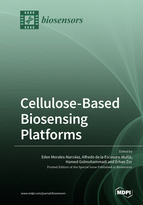Cellulose-Based Biosensing Platforms
A special issue of Biosensors (ISSN 2079-6374). This special issue belongs to the section "Biosensor and Bioelectronic Devices".
Deadline for manuscript submissions: closed (31 July 2021) | Viewed by 54227
Special Issue Editors
Interests: nanobiosensors; lateral flow analysis; electrochemical biosensors; electrocatalysis; nanochannels
Special Issues, Collections and Topics in MDPI journals
Interests: biophotonics; optically active nanomaterials; graphene and 2D materials; wearable devices; point of care devices; biosensors; nanocomposites; microarray technology; in vitro diagnostics
Special Issues, Collections and Topics in MDPI journals
Interests: graphene; nanocellulose; biosensors; chiral sensors; optical sensors, electrochemical sensors, paper-based diagnostics; biomedical diagnostics
Special Issues, Collections and Topics in MDPI journals
Interests: (nano)paper-based sensors; optical biosensing; Smartphone IoT-based sensors; wearable sensors; point-of-care devices; ingestible sensors; cellulose-based microfluidics; optical sensor array; nature-based (nano)materials
Special Issues, Collections and Topics in MDPI journals
Special Issue Information
Dear Colleagues,
As the most abundant renewable biopolymer in nature, cellulose is a convenient family of materials to design low-cost devices. In addition, cellulose-based materials are flexible, biocompatible, biodegradable, and amenable to straightforward functionalization, as well as mass production. These unrivaled features of cellulosic substrates—including paper, textile/thread and nanocellulose—and their fascinating simplicity of fabrication and coupling with ubiquitous technologies such as smartphones make them tailor-made biosensing platforms. Furthermore, cellulose-based biosensing approaches can meet the World Health Organization’s ASSURED (affordable, sensitive, specific, user-friendly, rapid and robust, equipment-free, and deliverable to end-users) criteria for ideal diagnostic assays/devices. Hence, cellulose endows the biosensing community with exquisite materials to envisage innovative analytical devices.
This Special Issue will be focused on cutting-edge approaches dealing with the design, fabrication, and advantageous analytical performance of cellulose-based biosensing platforms, including but not limited to paper, textile/thread, and nanocellulose-based biosensing technology. The applications portfolio may embrace medical/clinical diagnostics, health care, point-of-care-testing, environmental monitoring, food analysis or other biochemical and biological analysis.
Dr. Alfredo de la Escosura-Muñiz
Prof. Eden Morales-Narváez
Dr. Erhan Zor
Dr. Hamed Golmohammadi
Guest Editors
Manuscript Submission Information
Manuscripts should be submitted online at www.mdpi.com by registering and logging in to this website. Once you are registered, click here to go to the submission form. Manuscripts can be submitted until the deadline. All submissions that pass pre-check are peer-reviewed. Accepted papers will be published continuously in the journal (as soon as accepted) and will be listed together on the special issue website. Research articles, review articles as well as short communications are invited. For planned papers, a title and short abstract (about 100 words) can be sent to the Editorial Office for announcement on this website.
Submitted manuscripts should not have been published previously, nor be under consideration for publication elsewhere (except conference proceedings papers). All manuscripts are thoroughly refereed through a single-blind peer-review process. A guide for authors and other relevant information for submission of manuscripts is available on the Instructions for Authors page. Biosensors is an international peer-reviewed open access monthly journal published by MDPI.
Please visit the Instructions for Authors page before submitting a manuscript. The Article Processing Charge (APC) for publication in this open access journal is 2700 CHF (Swiss Francs). Submitted papers should be well formatted and use good English. Authors may use MDPI's English editing service prior to publication or during author revisions.
Keywords
- Biomaterials
- Bioplatforms
- Biosensors
- Cellulose-based microfluidics
- Diagnostics
- Electronic textiles
- Environmental monitoring
- Food analysis
- Health care
- Lateral flow immunoassay
- Micro/nanocellulose fibrils
- Multiplexed detection
- Nano/composite materials
- Nanocellulose
- On-site detection
- Paper cutting
- Paper-based analytical devices
- Photolithography
- Point-of-care devices
- Point-of-care Testing
- Portable devices
- Preventive health care
- Smartphone and paper-based biosensors
- Textile-based biosensors
- Thread-based biosensors
- Wax/inkjet/screen printing
- Wearable sensors
- (Nano)cellulose-based biosensors
- 3D-printed paper-based microfluidics










